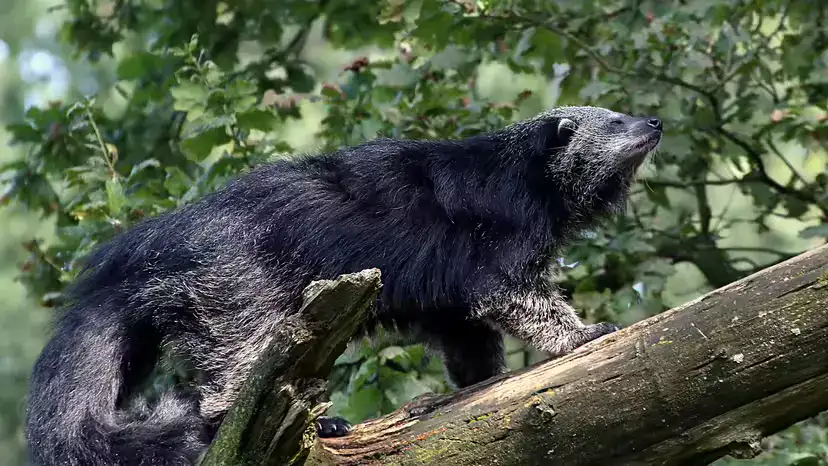Scientific name: Arctictis binturong
Common names: Binturong, Bearcat
Order / Family: Carnivora / Viverridae (the civet family)
IUCN status: Vulnerable
Body length: 60–96 cm (24–38 in)
Tail length: 55–90 cm (22–35 in), fully prehensile
Weight: ~9–14 kg (20–31 lb), occasionally larger
Notable trait: “Popcorn” scent from glands/urine
Diet: Mainly fruit (especially figs), plus birds, insects, eggs, and small vertebrates

Despite the nickname “bearcat,” the binturong is neither a bear nor a cat. It belongs to the viverrid family along with civets and genets. Stocky and shaggy with rounded ears and a long grasping tail, it is built for life in the trees of Southeast Asia’s forests.
Dense black to dark gray fur with grizzled guard hairs
Rounded, tufted ears; whiskered face; eyes adapted to dim light
Fully prehensile tail with a bare, grippy patch underneath the tip—used like a fifth limb for climbing
Slow, deliberate climber; sure-footed on branches but too heavy to leap gaps
Binturongs communicate heavily through scent marking, like many carnivores. What makes them famous is a warm, buttery “hot popcorn” odor associated with their scent glands and urine. The smell helps individuals signal territory and reproductive status as they travel along branches and tree trunks.
They are mostly crepuscular to nocturnal, typically solitary or found as a mother with dependent young.
Binturongs occur patchily across Southeast Asia, including parts of Thailand, Cambodia, Laos, Vietnam, Peninsular Malaysia, Indonesia (Sumatra, Java, Borneo/Kalimantan), and the Philippines (selected islands).
They favor evergreen and mixed tropical forests from lowlands to mid-elevations. As largely arboreal mammals, they spend much of their time in the canopy but must descend to the ground to move between trees—because they do not leap like primates.
Researchers have proposed up to nine subspecies, but boundaries are unresolved due to the species’ elusive habits and limited data. Binturongs also live in zoos worldwide, which support research and public education.
Binturongs are omnivores with a strong frugivorous bias. Figs (Ficus spp.) are a favorite, supplemented by birds, insects, small reptiles, and eggs.
By eating fruit and passing seeds intact, binturongs act as seed dispersers, helping maintain forest diversity—particularly important for fig trees that feed many other wildlife species.
Breeding can occur at multiple times of year (varies regionally).
Reported gestation ~90 days (estimates vary); typical litter size 1–3.
Mothers provide most care; young begin climbing and foraging alongside the mother after a few months.
Lifespan in human care can exceed 15 years; wild data are limited.
IUCN Red List: Vulnerable. Populations are thought to be declining across much of the range.
Major threats
Habitat loss and fragmentation from logging and conversion of rainforests to oil-palm plantations, especially in southern portions of the range.
Hunting and trade (food, traditional medicine, and the pet trade), which dominate in some northern areas.
Roadkill and conflict risks increase where forests are fragmented and animals must travel on the ground.
Priority actions
Protect and restore contiguous native forest and canopy connectivity.
Strengthen enforcement against illegal hunting and trade.
Support community-based conservation and alternative livelihoods near forest edges.
Use zoo/NGO programs for education and potential insurance populations.
Pets? Not suitable. Their scent marking, specialized diet, strong claws, and space needs make them poor household animals; many jurisdictions also restrict or prohibit keeping wildlife.
Crop issues: In fruit-growing areas, non-lethal measures (netting, buffer trees, and compensation schemes) are recommended to reduce conflicts.
Is a binturong related to bears or cats?
No. It’s a viverrid, closer to civets than to bears or felids.
Do they really smell like popcorn?
Many observers report a hot-popcorn or caramel-corn smell linked to their scent secretions and urine, used for territorial communication.
What do they eat most?
Fruit—especially figs—plus opportunistic animal prey (insects, birds, eggs, small vertebrates).
Where can I see one?
They’re widespread but uncommon in Southeast Asian forests and are also kept in accredited zoos.
Why are they threatened?
Forest conversion (notably to oil palm), hunting, and the wildlife trade are the leading pressures.
animal tags: binturong
We created this article in conjunction with AI technology, then made sure it was fact-checked and edited by a Animals Top editor.